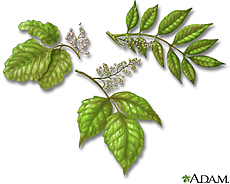National Institutes of Health
- The primary NIH organization for research on Poison Ivy, Oak and Sumac is the National Institute of Arthritis and Musculoskeletal and Skin Diseases
 A service of the U.S. National Library of Medicine
A service of the U.S. National Library of Medicine  National Institutes of Health
National Institutes of Health
If you spend time outdoors, chances are you have been bothered by poison ivy, poison oak or poison sumac at some point. Most people are sensitive to the plants' oily sap. The sap is in the root, stems, leaves and fruit of these plants. If it gets on your skin, it causes a blistering skin rash. The rash can range from mild to severe, depending on how much sap gets on your skin and how sensitive you are to it. Problems can also happen if the plants are burned. Airborne sap-coated soot can get into the eyes, nose, throat and respiratory system.
The best way to avoid the rash is to learn what the plants look like and stay away from them. If you come into contact with the plants, wash your skin and clothing right away. If you develop a rash, ask your pharmacist about over-the-counter medicines. For severe rashes, see your doctor.
National Park Service
References and abstracts from MEDLINE/PubMed (National Library of Medicine)
